Pilot Projects Advance Regenerative Agriculture — and Growers Are Crucial


Agriculture is the world’s largest industry and an immense emitter of greenhouse gases. While the evolving alternative — regenerative agriculture — mitigates the industry’s negative environmental impact, it lacks a legal and regulatory definition.
Regenerative agriculture is commonly described as a collection of practices that mitigate the impact of climate change and sustain natural habitats. It emphasizes ecosystem health through increased carbon sequestration and improved water quality, soil health and natural habitats.
Despite this, only 51 percent of research articles that reference regenerative agriculture define it, according to a review published in Frontiers in Sustainable Food Systems. And although 84 percent of practitioner organizations also define the term, when it is defined its meaning varies drastically. The lack of global consensus poses a challenge to advancing these practices and measuring the impact for growers, policymakers and researchers.
Protecting biodiversity and sustaining natural habitats is no easy task. The practices under the umbrella of regenerative agriculture require study, a trial-and-test method and, ideally, documentation — all of which pilot projects provide.
Pilot projects are high-stakes tests with long-term rewards
As the regenerative agriculture market grows, its challenges grow, too. Consumers’ have limited knowledge on best practices. And there is limited scientific understanding of some of its concepts such as carbon reduction and the potential of cover crops. Other challenges include production cost, resource cost and the high demand for low-cost goods.
Pilot projects are the best initial step in understanding and expanding regenerative agriculture practices to overcome these challenges. By creating standardization and communication, the projects help consumers understand and support the system. These projects help solidify successful practices and metrics to consider, provide insight to growing specific foods, and foster important partnerships between governments and companies. As definitions and results are solidified, more industry players can work together to overcome costs of regenerative agriculture and encourage its adoption.
Global interest in regenerative agriculture is growing — particularly in the private sector — as numerous companies engage with its practices in different ways. General Mills pledged to expand regenerative agriculture on 1 million acres of farmland by 2030. And groups like the Regenerative Organic Alliance have established certificates for regenerative agriculture. While all engagement with this concept is positive, pilot projects in particular hold tremendous opportunities to advance the practice.
What makes regenerative agriculture pilot projects successful
Regenerative agriculture pilot projects require resources, financial support, and a solid relationship between growers and project leaders.
Caitlin Birkholz, regenerative agriculture pillar lead at Kind Snacks, explained what is lacking in the regenerative agriculture industry and its pilot projects during an in-person tour of the Kind Almonds Acres Initiative plot. The company is working with one of its top almond suppliers, Ofi, to test six innovative agriculture practices across six plots within a 500-acre space in Fresno, California.
Similar projects often face challenges when growers aren’t included, Birkholz told reporters at the Fresno plot last month. "Something that is incredibly important when designing a regenerative agriculture project is to get close to the grower,” she said. “The grower is your most important asset. They know everything.”
Omitting growers from pilot projects often limits their ability to scale, Birkholz said. “A pilot can be really great. You can be really excited about a pilot. But if you don’t include the grower and the local community, it’s really hard to get those practices to be adopted by growers around the region.”
No location or environment is the same. These projects develop the location and growing-specific knowledge critical for regenerative agricultural practices. And align with broader industry interests and goals. All of which requires transparency, innovation in supply chains and relationship-building.
In addition to commitments and research, this industry requires testing. It is time for leaders to deliver.
Image credit: Zeno Group
Editor's Note: Travel and accommodations to California’s Central Valley were provided by Kind Snacks. Neither the author nor TriplePundit were required to write about the experience.
Companies Leading the Way on Second Chance Hiring
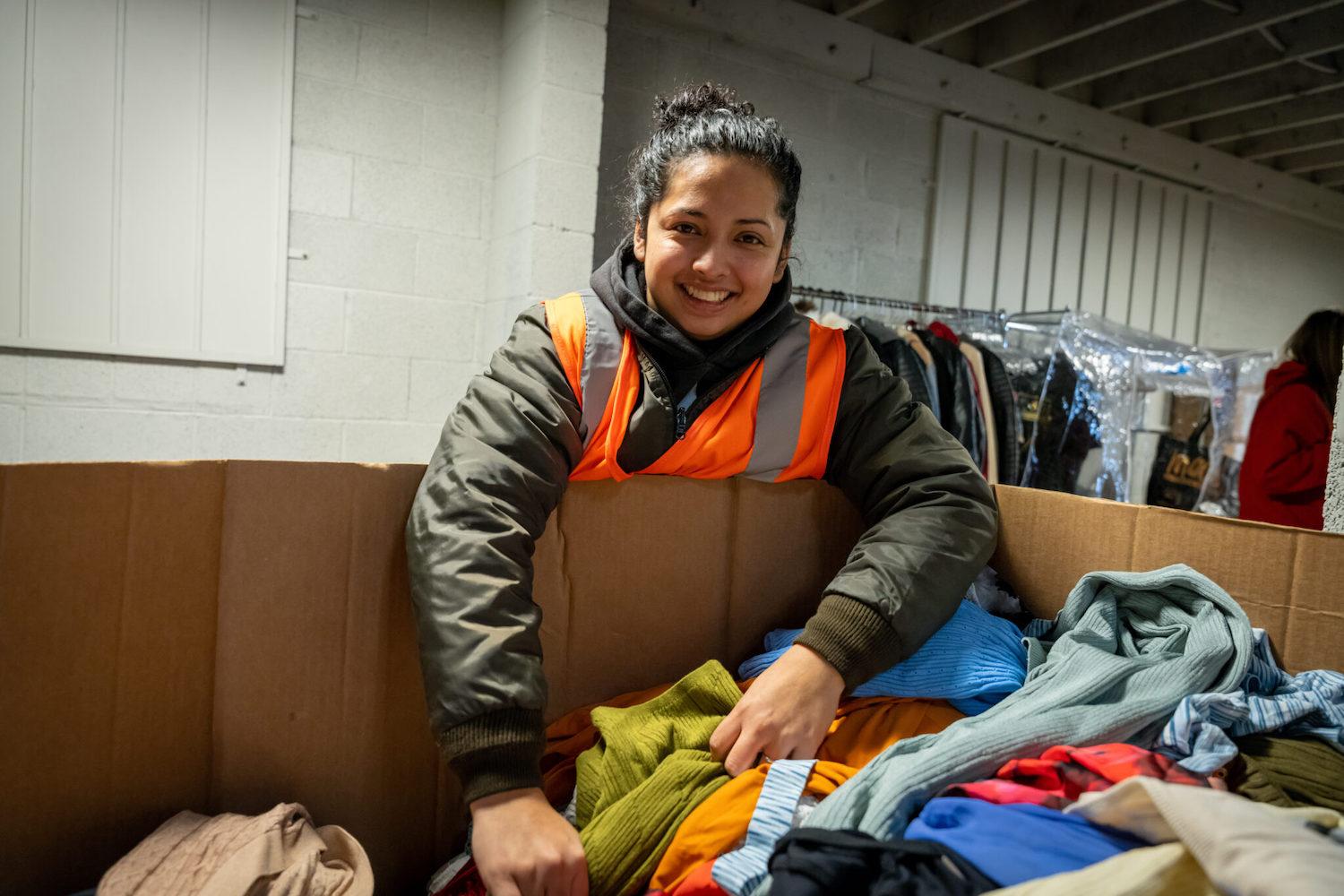
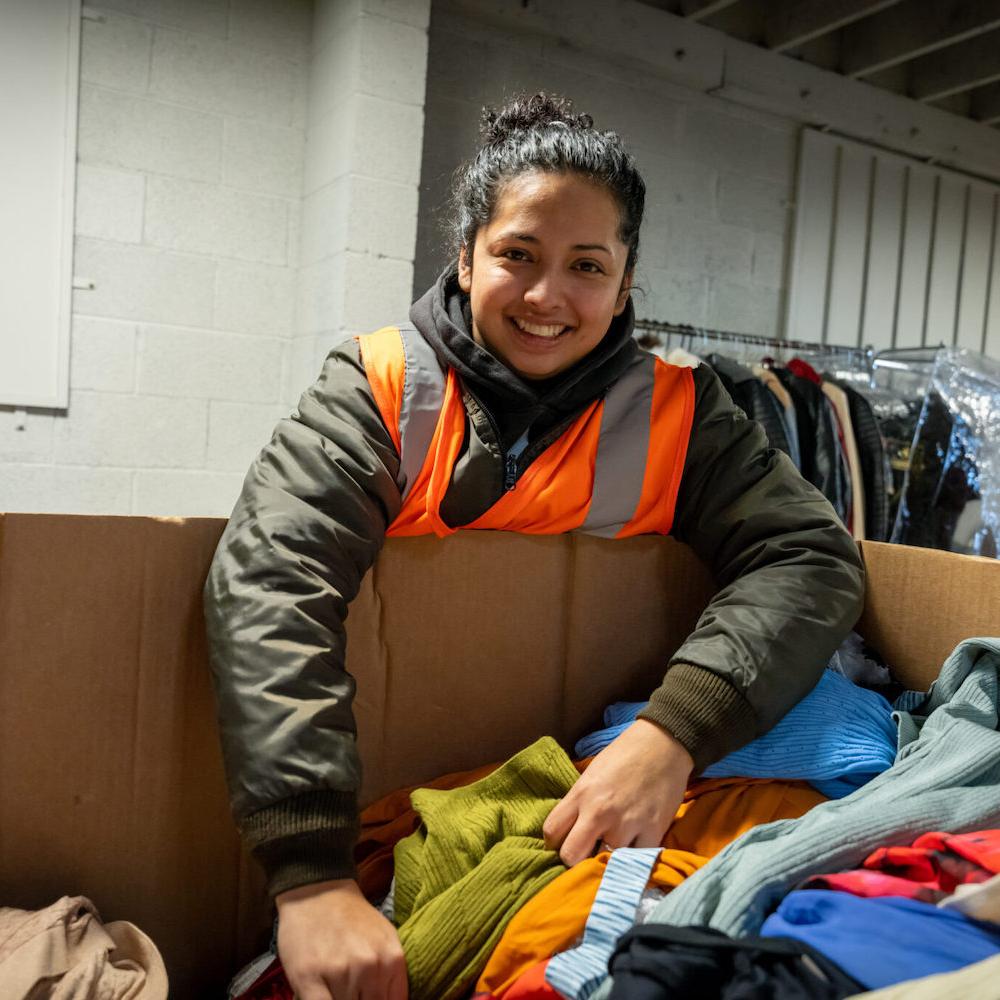
Homeboy Threads helps brands like Guess run clothing resale and recycling programs while offering jobs to formerly incarcerated people. (Image credit: Homeboy Industries)
Around 1 in 3 U.S. adults has a criminal record that would appear on a routine background screening. Even after serving their sentences, people with criminal justice histories are often cast aside by employers, locked out of housing, and deemed too high-risk for loans and other financial services. More than half of those leaving U.S. prisons are unemployed a year later, increasing the likelihood they’ll return.
Second chance hiring is based on the simple principle that a person's past does not define them, and those who have served their time should have a fair shot at employment and a place in their communities.
Not only does second chance hiring provide an opportunity for business to change lives, but there's also a massive economic incentive: Locking people with criminal backgrounds out of the workforce costs the U.S. economy an estimated $87 billion every year, according to JPMorgan Chase, which has grown into an outspoken advocate for second chance hiring. Here are some other companies that are leading the way on the practice as it begins to take hold across the private sector.
Second Chance Business Coalition brings big employers into the mix
The Second Chance Business Coalition launched in 2021 to provide companies with the tools, relationships, and expertise they need to advance second-chance opportunities within their organizations. Its membership has grown to nearly 50 large U.S. employers, from Best Buy and Target to Mastercard, Accenture and Deloitte.
About half of member companies reported on the internal changes they made within the coalition's first two years — and these early findings indicate a strong uptake of second-chance programming that goes beyond checking a box.
For example, of those members that reported data, nearly 75 percent said second-chance candidates made up more than 5 percent of their new hires. The majority of the coalition's corporate members also reviewed or updated their HR policies, established new programs to intentionally recruit second-chance candidates, and partnered with re-entry organizations on hiring and support for employees with records.
Still, challenges remain — with over half of members saying they faced regulatory hurdles when looking to hire people with any or certain types of criminal history. The coalition plans to release a set of guidelines later this month to outline the legal challenges employers face and provide guidance on how to address them.
Workforce and Justice Alliance connects newcomers and early adopters
Meanwhile, the Workforce and Justice Alliance launched last year to bring businesses together to remove workforce barriers for justice-impacted individuals. Formed by the Responsible Business Initiative for Justice (RBIJ), an international nonprofit that works with companies to champion criminal justice reform, the Alliance also includes leadership from Mod Pizza — an early champion of second chance hiring policies.
Many of the Alliance's members are early adopters like Mod Pizza and I Have a Bean. Others, like Flikshop — which sends photos to incarcerated people as postcards and offers free service to children with incarcerated parents — are founded by people with records. Of those companies that are newer members to this space, many have already changed their internal practices to reflect the challenges returning citizens face, according to an update from the Alliance shared earlier this year.
Crossroads Solar makes panels in the U.S. with a second chance workforce
Indiana-based Crossroads Solar creates high-quality, U.S.-made solar panels, and its factory is staffed entirely by formerly incarcerated people who are paid a living wage. Founders Patrick Regan and Martin Whalen spent years teaching courses at local prisons as part of the Moreau College initiative, a collaboration of the University of Notre Dame and Holy Cross College that provides liberal-arts educations to people in prison.
In 2020, they launched Crossroads Solar to create employment opportunities for people like their students after release. Today, many of the company's employees are recruited after taking Moreau courses. "Our workforce has been nothing short of stellar," Regan wrote in a newsletter update last year.
The company has big plans to expand, moving away from the "gigafactory" model that centralizes workers and prioritizes automation to a vision where more people across the country can get good-paying jobs in solar manufacturing. "A distributed model would envision 20 Crossroads-size factories around the country each producing 40ish [megawatt-hours] of output and each providing great jobs to men and women that traditionally struggle with employment," Regan wrote. The company is in talks with groups from Native communities to prisons to get the plans moving, he said.
Open hiring pioneer Greyson Bakery gets more companies involved
Getting a job at Greyston Bakery in Yonkers, New York, is as simple as writing your name. Greyston pioneered the practice of "open hiring" back in 1987 — and it has built its team without interviews, job applications or background checks ever since. Applicants simply write their names on a list, and they’re hired on a first come, first served basis — no questions asked. Benefits begin on day one, and new hires go through a seven- to nine-month apprenticeship before becoming full-fledged bakers for the company that supplies major brands like Ben & Jerry's.
“We always say we don't hire people to bake brownies. We bake brownies to hire people," Joseph Kenner, vice president of programs and partnerships for Greyston Bakery, said at the 3BL Forum: Brands Taking Stands back in 2019.
Greyston’s model gives an unconditional second chance to people with criminal justice histories, as well as those experiencing homelessness, substance abuse issues or who are, for whatever reason, struggling to find steady work. The bakery also works with other employers including Unilever and the Body Shop to scale open hiring across the labor force.
Homeboy Industries leverages social enterprise to power second chance employment at scale
Operating under the motto "jobs not jails," Homeboy Industries offers employment, education, and other services to former gang members after they are released from prison.
The 35-year-old nonprofit has grown from a single bakery to almost a dozen social enterprises — from cafes and farmers markets to silkscreen shops and catering — which provide real-world training for people leaving prison while bringing in revenue to support Homeboy's re-entry work. Its latest venture, Homeboy Threads, helps brands like Guess run clothing resale and recycling programs while offering jobs to formerly incarcerated people.
Having served well over 100,000 people in its home city of Los Angeles since 1986, it now powers the Global Homeboy Network of more than 400 organizations committed to giving formerly incarcerated people a second chance.
Dave's Killer Bread keeps spreading the word about open chance hiring
Dave's Killer Bread got its start at a Portland farmers market. Nearly two decades later, it's the No. 1 best-selling organic bread in the country, available in stores nationwide. Around a third of the company's staff are formerly incarcerated, and it launched the Dave's Killer Bread Foundation in 2015 to equip other businesses to adopt second chance hiring.
The national nonprofit Jobs for the Future took over management of the Foundation's second chance hiring program earlier this year and plans to continue its Second Chance Corporate Cohorts — which train HR leaders to adopt the practice. Over 30 companies have already completed the program, including Dick's Sporting Goods, Cisco and Gap, Inc.
Indeed builds from early roots to big impact
Indeed's first employee, a software engineer who built the infrastructure for the job listing site back in 2004, was formerly incarcerated. The company has been an outspoke proponent of second chance hiring ever since. It's looking to help 30 million people facing employment barriers get jobs by 2030, with a focus on breaking down biases toward criminal justice history.
That includes work with partners like Banyan Labs, a software development company that trains and supports people with records and helps them find jobs in the field. Another $10 million initiative dubbed Essentials to Work looks to help Americans facing barriers to employment, including legal resources to help job-seekers have their records expunged. The company also includes a fair-chance commitment on all of its U.S. job descriptions.
With Public Opinion on Their Side, Corporations Begin to Fight for ESG
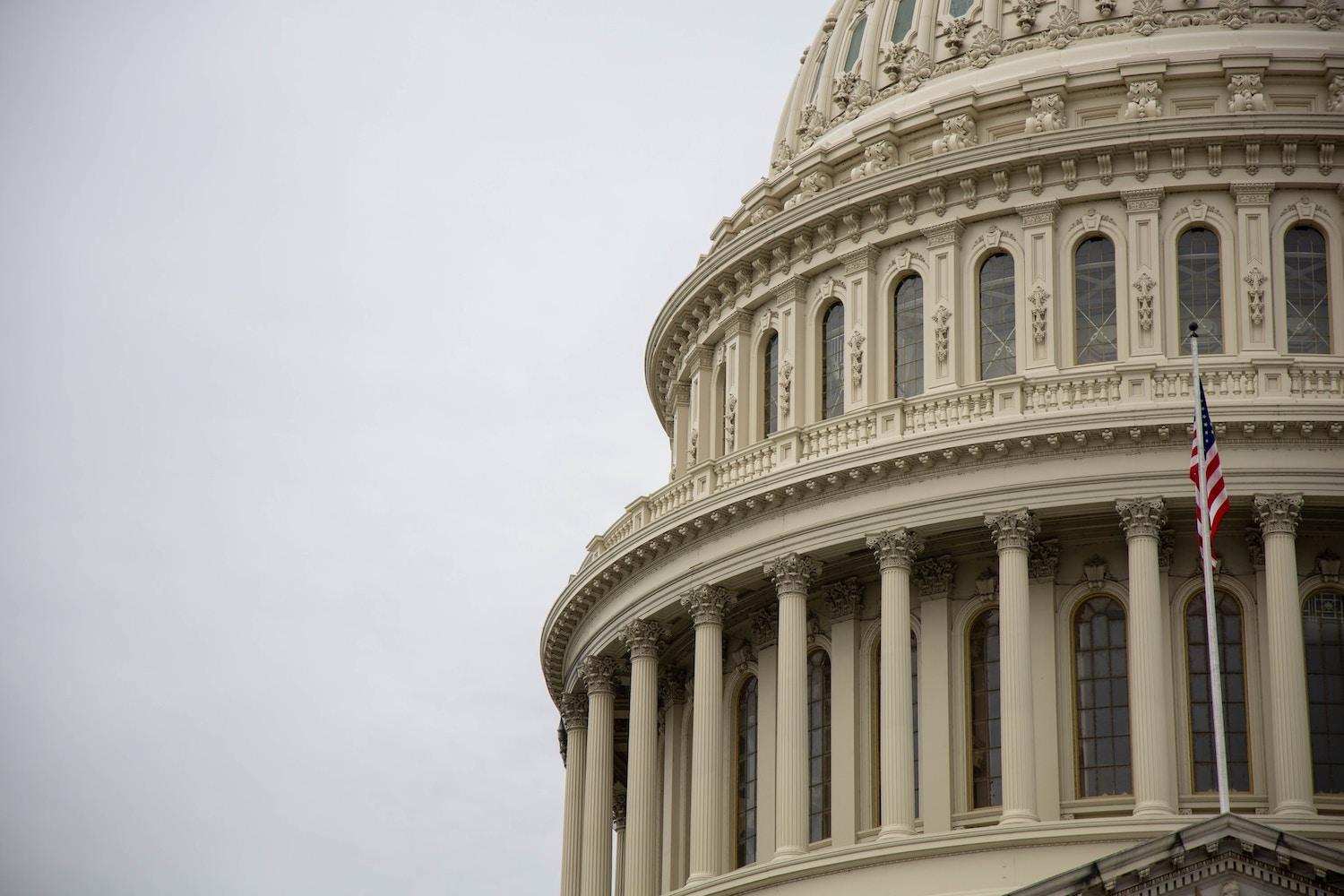
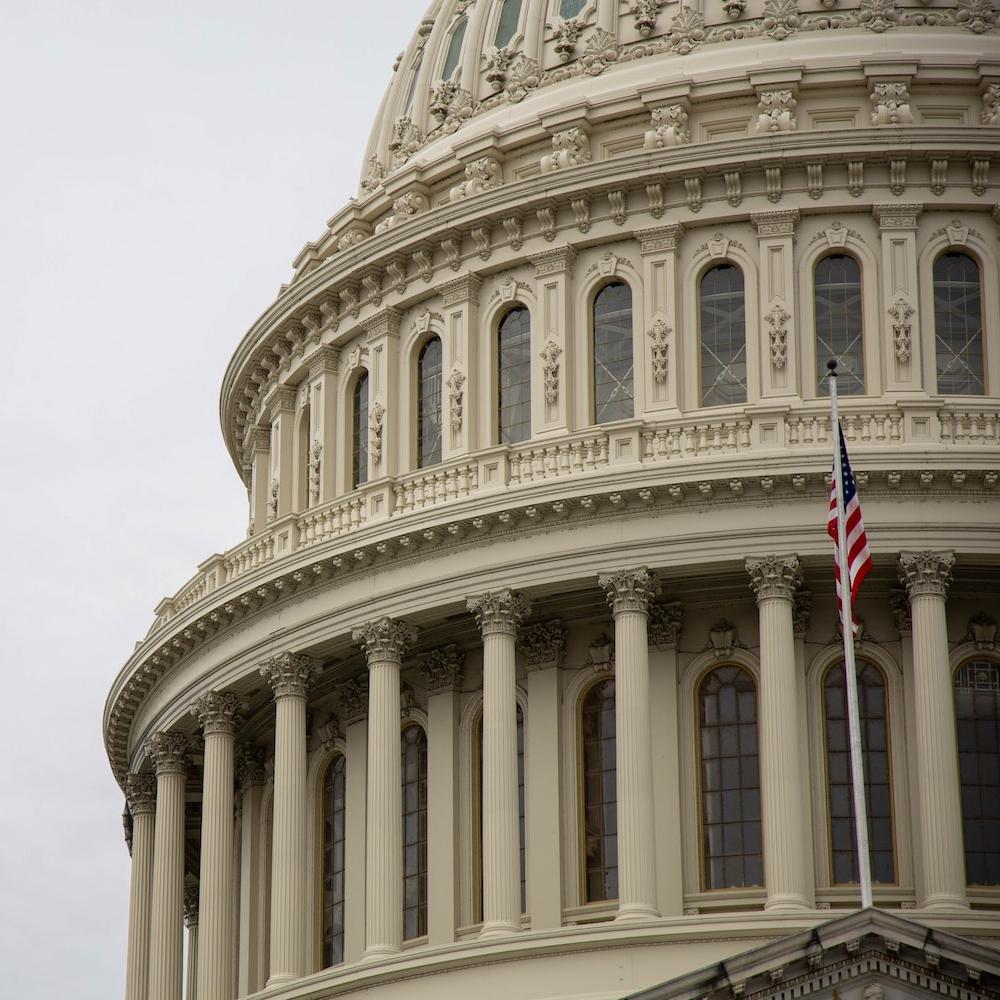
An organized effort to prevent corporations from practicing ESG (environmental, social and governance) principles has gained traction among state-level Republican officials in recent years. They typically deploy scary rhetoric about the evils of “woke capitalism” to make their case against ESG investing and corporate practices. However, the movement is beginning to run out of steam. Business leaders are pushing back, and a new study from Rokk Solutions indicates that voters on both sides of the political divide are siding with them.
The anti-ESG movement sowed the seeds of its own destruction
From the beginning, many have said the anti-ESG movement was nothing more than a thinly disguised effort to protect fossil energy industries and prevent investor dollars from flowing into decarbonization technologies, including energy storage as well as wind and solar power. Some anti-ESG measures are also aimed at protecting gun industry stakeholders.
In some cases, there has been no disguise at all. Republican office holders in Texas, for example, passed a state law in 2021 that explicitly prohibits state pension funds from doing business with financial firms that “boycott” fossil energy industries.
Anti-ESG laws are ostensibly aimed at protecting pensioners, but because they have no basis in actual bottom-line impacts, they can backfire. In some cases, banks and other investment firms can pack up and take their business elsewhere. In Texas, for example, competition dried up after the anti-ESG law passed, costing the small city of Anna $277,334 on its bond sale.
In addition to interfering with direct bottom-line decisions, the anti-ESG movement also interferes with businesses that are pursuing DEI (diversity, equality and inclusion) goals. A strong DEI policy helps businesses to attract and retain top talent while building stronger relations with communities, consumers and clients. In contrast, the anti-ESG position overlaps with the “woke capitalism” canard and with hate speech expressed by white supremacists and religious extremists, a sentiment that poses reputational risks for businesses.
Big business quietly finds its voice
To a great extent, businesses only have themselves to blame. Many U.S. corporations have provided financial support to help raise Republicans to power in both the legislative and judicial branches, only to see the “party of big business” suddenly turn around and become their enemy.
But those financial ties may have helped some business leaders gain the ear of Republican office holders. Earlier this week, reporter Ross Kerber of Reuters took a deep dive into the issue. Among other leaders, he spoke with Lauren Doroghazi, senior vice president at the consulting firm MultiState Associates, who said businesses have seen some success lobbying against anti-ESG bills. Doroghazi estimates that businesses and their allies have succeeded in nipping more than 80 percent of state-level, anti-ESG proposals in the bud, though many still remain on the table.
Kerber also spoke with BlackRock Chief Financial Officer Martin Small, who also indicated that investment firms have had some success in alerting Republican office holders to the potential for anti-ESG bills to backfire and the resulting costs for public pension plans.
For example, earlier this month in Kansas, the state’s own Division of the Budget released an estimate that a newly proposed anti-ESG bill would cut state pension returns by $3.6 billion over a 10-year period, Kerber reported. Legislators made some changes in the bill, and a watered-down version eventually passed into law on April 24. However, it still includes provisions aiming to prevent public officials from considering ESG principles in financial transactions.
Your indoor voice is not working
So far, most of the corporate pushback against anti-ESG laws is happening in meetings behind closed doors. That strategy has met with much success, according to Doroghazi’s analysis. But the approximately 1 in 5 anti-ESG laws that do pass could do considerable damage. Even if banks and other financial firms suffer little direct impact, businesses could still feel the ripple effect and reputational loss of doing business in states with anti-ESG regulations and increasingly repressive social policies.
Businesses can and should begin listening to public opinion and amplifying the public's voice. Survey after survey shows that the majority of U.S. voters and other adults support climate action, abortion rights, racial and gender equality, restrictions on gun ownership, and other progressive values that are consistent with corporate ESG principles.
The fact is that the public voice needs help. Minority rule by Republican office holders has become a feature in states like Wisconsin, where gerrymandering has provided Republican districts with outsized power relative to their population.
With red-state Democratic representation concentrated in cities, state-level Republican office holders can also consolidate power by stripping municipalities of their authority to govern. In Texas, the state legislature is currently considering a bill that would pre-empt local control by cities and counties on a variety of issues including drought response, predatory lenders and worker protections. The Tennessee legislature has moved to undermine Democratic representation in Nashville, and the New York Times has described how state legislatures in Georgia and elsewhere are stripping power from local election boards.
It's time to pick sides on ESG
At the same time, the opinions of U.S. voters and consumers are becoming more aligned with ESG principles, and the up-and-coming generation of workers is turning away from employment in fossil energy industries.
Last week, the K Street communications firm Rokk Solutions issued an updated survey of voter opinions undertaken last year. The latest polling found that a majority of voters in both parties “believe corporate environmental action is relevant to their financial futures.”
“This belief increases for specific efforts like conservation and resource management,” the report reads. Strong majorities of both Republican and Democratic voters also view de-risking business as important to their financial futures. In particular, voters in both parties indicate that climate action is “important to their financial fortunes.”
“Republican support rises significantly for specific areas like water conservation, waste management and biodiversity,” Rokk found.
Republican voters are still skeptical of long-term climate goals, and a partisan difference of opinion persists on social issues, the report found. Still, the growing consensus on specific areas of sustainability provides businesses with a common ground on which to make the case for ESG investing, out loud and in public.
Image credit: Joshua Sukoff/Unsplash
What Does the New EU Deforestation Ban Mean for Business?


The European Parliament approved a new law last week to ban the import of commodities tied to deforestation, a leading cause of climate change that accounts for about 10 percent of global greenhouse gas emissions.
Every day, an area of forestland the size of New York City is lost to deforestation — largely linked to the expansion of land used for agriculture. Countries such as Brazil, Malaysia, Indonesia, Nigeria, Ethiopia, Mexico and Guatemala have lost an enormous amount of tree cover over recent years.
EU consumer demand alone is responsible for 10 percent of deforestation worldwide, according to the European Commission. The new law requires companies to undergo a due diligence process and provide traceable information that proves their products were not grown on areas deforested or degraded after 2020. The import ban largely affects palm oil, rubber, coffee, wood, beef and soy.
Companies must provide EU regulators with proof of their due diligence claims, such as geolocation coordinates of their operations, as well as statements from the company that the rights of Indigenous peoples living in the area are respected. The EU will use satellite technology and DNA sampling to verify geolocation coordinates.
What does the law mean for business?
Once individual EU countries formally approve the new rule, large companies will have 18 months to comply and small companies will have two years. Companies that do not comply with the new law will face fines of up to 4 percent of the company’s total turnover in the EU.
This move has alarmed growers and policymakers in countries most likely to be affected. Malaysia has threatened to stop exporting palm oil to the EU, as smallholder farms in Malaysia say they are unable to comply with the geolocation requirements. Brazilian agribusiness giant ABAG has also condemned the new law.
However, other countries have worked to stay ahead of the legislation. Ivory Coast is the world’s largest cocoa producer, and its Minister of Agriculture has already set up a registration and geolocation system for cocoa farmers across the country. Producers have been issued identity cards with the geolocation coordinates of their farms, and unregistered farms are not permitted to sell or market their cocoa. The Ivorian agriculture ministry is monitoring the average output of cocoa farms for any sudden growth that would indicate land expansion, and it has threatened prosecution for producers that engage in deforestation.
Similar deforestation laws soon to come in the U.S.?
The United States Congress is considering a similar bill. The Forest Act was introduced in the Senate in 2021 but has not been put to a vote. However, the passage of the EU law has given the U.S. bill new urgency.
Sen. Brian Schatz of Hawaii, who sponsored the bill, plans to reintroduce it this spring. “The EU is shutting its borders to products of deforestation, and the United States needs to follow suit," Schatz told the Guardian. "If we do nothing, the U.S. market will become a dumping ground for commodities that can no longer make their way into Europe.”
Meanwhile, activist organizations such as Greenpeace say the EU law doesn't go far enough, objecting to loopholes that exclude protections for crucial grassland and wetlands ecosystems and fail to prosecute European banks that finance deforestation projects.
Christophe Hansen, MEP from Luxembourg and lead EU negotiator for the legislation, told Euractiv the new law is “not perfect,” but a necessary start. The law requires reviews after one, two and five years to assess its scope — including whether it should integrate other land ecosystems, encompass a wider selection of commodities and products, and further regulate European banks, he said.
Hansen also called on the European Commission to set up a system that provides technical and financial assistance to smallholder farmers that cannot meet the requirements. “Otherwise what would they do? Well, probably deliver to somebody that is not having the same expectations,” he told Euractiv.
Image credit: Oleksandr Pidvalnyi/Pexels
Preserving Coral Reefs Through the Power of Listening (and a Little Help From AI)


You’ve likely heard about AI chatbots, the latest tech innovation sweeping the globe. But did you know that AI, or artificial intelligence, could also help save corals? Through a novel citizen-science project, time mindlessly wasted online can be put to use helping scientists understand, and even restore, the world's coral reefs.
Google teamed up with a pair of marine biologists, Steve Simpson and Mary Shodipo, to launch the Calling in our Corals project earlier this month. The platform aims to use acoustic recordings to measure the success of marine protected areas and other restoration programs, with a little help from everyday people as well as AI.
Coral reefs are a hotspot for biodiversity and provide a range of benefits for people and the environment, but they're also one of the most threatened ecosystems on Earth. Soundscapes are a promising new tool to help restore them. Plus, unlike cat videos, listening to the weird cacophony of coral sounds is a guilt-free distraction.
How does this AI model work?
Marine biologists have recorded the surprisingly vibrant sounds of coral reefs in 10 countries. The chirps and grunts of healthy reefs burst forth like a lively metro area at rush hour, while the muted tones of damaged reefs resemble a sleepy village. Anyone can log onto Google's platform to listen to these reef recordings and identify sounds made by fish, shrimp and other underwater animals. These crowd-sourced data are then used to train an AI model.
AI may sound like something out of a science fiction movie, but this branch of computer science was invented in the 1950s. It works by taking in large amounts of training data, crunching the data for patterns, and using those insights to make predictions.
Scientists have collected hundreds of hours of recordings, so they need many participants to sculpt training data out of this ocean of underwater acoustics. The researchers plan to use this tool to better understand coral reef diversity and hopefully pinpoint individual species.
But that’s not all. Impressively, this tool may also help to restore reefs. Some animals, like fish larvae, corals and other invertebrates, spend their larval stage in the open ocean. The sounds of a healthy reef act like a beacon, encouraging juvenile animals to settle there. Consequently, playing the music of healthy reefs on underwater speakers may accelerate their regrowth and restoration.
Coral reefs benefit people and the planet
Noisiness aside, restoring these valuable habitats provides many benefits. For starters, coral reefs are one of the most biodiverse places on the planet. Known as the rainforests of the sea, they cover only around 1 percent of the ocean floor but support nearly 25 percent of all marine species, including fish, turtles, corals, lobsters, sponges, sea stars and clams. Numerous commercially-fished species depend on coral reefs during part of their life cycle, generating more than $100 million annually in the U.S. alone. Likewise, recreational fishing on coral reefs contributes an additional $100 million each year to the U.S. economy.
But that’s just skimming the surface. Coral reefs also act as natural breakwaters that buffer us from the ocean. Reefs can absorb up to 97 percent of a wave's energy, protecting shorelines from storms, waves and floods. This prevents erosion, property damage and loss of human life in coastal communities. Globally, coral reefs are estimated to reduce storm damage by nearly $5 billion each year.
Finally, it’s no secret that coral reefs are beautiful places. Millions of tourists flock to these places for diving, snorkeling and boating — contributing an impressive $44 billion to local economies annually across the globe. Overall, coral reefs provide food, livelihood, shoreline protection and other services to a billion people.
But they're under increasing threat
Unfortunately, the global extent of these habitats has declined by half since the 1950s, with subsequent losses in biodiversity and catches of coral-reef-associated fish. The coral reefs remaining are predicted to degrade rapidly over the next 20 years.
Coral reefs face a laundry list of threats including coastal development, sediment runoff, pollution, invasive species, poorly managed tourism and unsustainable fishing practices. And then there’s climate change, the screeching trombone of the coral reef symphony.
Global warming fuels rising ocean temperatures, which can stress corals. Prolonged periods of extreme temperatures can lead to coral bleaching as corals expel their symbiotic algae. Without the helpful algae, corals lose their vibrant hues and major food source. They’re also left more vulnerable to disease. Bleaching events often kill corals outright, while less severe incidents can weaken corals by reducing their growth and reproduction. Regrettably, bleaching events have become five times more frequent since the 1980s. Ocean acidification, another side effect of climate change, can also slow coral growth and weaken their skeletons.
How you can get involved
Coral reefs are vital ecosystems that need protection. If you have the time, start training and contributing to the listening project. Training lasts only three minutes, while the clips of reef sounds are just 30 seconds each.
This citizen-science project makes a great activity or contest for students, companies or clubs. It’s an easy and fun way to help one of the world’s most valuable habitats and safeguard the multitude of benefits they provide.
Image credit: Belle Co/Pexels
With Indigenous Roots, Cheekbone Beauty Celebrates Sustainability and Representation


In 2015, Jenn Harper had a dream that proved to be life changing — not only for her, but also for a $500 billion beauty industry struggling with sustainability and diversity challenges.
“This was a real dream, not a metaphorical dream, of little Native girls dancing, giggling and exuding such genuine joy — and they were covered in lip gloss,” Harper told TriplePundit. “I woke up and instantly wrote down what became my business plan. I always say this, but the world didn’t need another lipstick brand. What the world did need, however, was more representation.”
Harper is now the CEO of Cheekbone Beauty, which she founded from her basement in Ontario, Canada, back in 2016. The company is built on the principles of high-quality, cruelty-free beauty products with low environmental impact.
Harper’s Anishinaabe roots became a part of the creative process — inspiring the product names. A portion of the sales are donated to help address the educational funding gap for Indigenous youth. To date Cheekbone Beauty has donated over $150,000 to various causes.
“I really wanted to create a brand that highlighted Indigenous faces and gave back to the community,” Harper told 3p. “On a personal level, I felt a lack of belonging in the space, and I never wanted another Indigenous youth to feel that way again.”
Shedding light on intergenerational trauma
Harper uses her platform to shed light on the impacts of intergenerational trauma within Indigenous communities as a result of Canada’s history of forcing Indigenous children to attend boarding schools from the 19th century until the 1970s.
“In Canada, the government tried to assimilate Indigenous people by forbidding our ways of life — our food, our dress, our language,” she said. “Our children were taken from their families and put into residential schools where they were forced to adapt to a European way of being. These traumas continue to be passed on. Our community needs to know they’re not alone. We need to recognize the pain and trauma that Indigenous families have experienced in order to start healing.”
From that painful history, Harper found healing and a concept for products that do not add to the beauty industry’s huge environmental challenges, such as excessive packaging, plastic pollution and unsustainable resource consumption. The global cosmetics sector creates 120 billion pieces of packaging every year, the recycling company TerraCycle told the Guardian.
Blending Western and Indigenous knowledge
Harper is on a mission to address these challenges with sustainable products rooted in Indigenous teachings and ways of being. Cheekbone Beauty’s brand statement — Indigenous Roots, Sustainable by Nature — says it all.
“Indigenous people are the OG’s of sustainability,” she said. In line with her Anishinaabe roots, Cheekbone’s sustainability journey looks to blend Western science with Indigenous wisdoms — a co-learning concept known as Two-Eyed Seeing, developed by Mi’kmaw elder Dr. Albert Marshall. “This concept nurtures the strengths of Western science and Indigenous knowledge for the benefit of living things within our environment,” Harper explained.
Concerned with the negative environmental impacts of excess packaging and mass production, Harper and her team spent the last three years researching and creating products with the idea of using less. The company’s first line, launched in 2020, was a low-waste line of lipsticks called Sustain. All the products are fair trade, not tested on animals, vegan, and meet the Clean and Planet Positive standards set by Sephora Canada. Cheekbone Beauty also measures ingredients against its in-house Biinad Standards — biinad from the Cree word for “clean.”
“This is a journey, so we see the need for new, better innovation all the time,” Harper said. “It comes at greater cost, but this is our Indigenous responsibility to the land. Everything we put out for our consumers is created with Indigenous teachings in mind.”
Meeting growing consumer demand
Harper is encouraged by consumers’ growing interest. Two-thirds of consumers say they will pay more for sustainable products, according to a report from First Insight and the University of Pennsylvania Baker Retailing Center. Sustainability is very important to 64 percent of consumers when considering purchasing a beauty product in particular, according to a survey by the Benchmarking Company.
“People work hard for their money and want to make informed decisions before purchasing products, especially in such a saturated industry,” Harper said. “A lot of beauty consumers are switching to more clean brands that offer refillable or recyclable packaging, as opposed to single-use packaging that ends up in landfills. It’s all about perspective and understanding how and why consumers are making their decisions and adapting as a brand.”
Images courtesy of Cheekbone Beauty
The FTC Moves to Update Its Green Guides, But Can They Have the Desired Effect?


The U.S. Federal Trade Commission (FTC) may soon enact stricter rules against greenwashing. The agency is taking public comments on its Green Guides, established in 1992 to assess sustainability claims. Changes are certainly due — especially considering the ubiquity of false claims across marketplaces. But without an enhanced budget for enforcement, new rules are unlikely to have the teeth they need to make a difference. The issue also begs the question: How can the FTC even begin to define “green” with so many competing factors?
Greenwashing in action
Examples of greenwashing abound — from misleading claims about a product's recyclability or compostability to misrepresentations of companies’ carbon footprints, the certification of illegal logging, and more. Naturally, some of the most egregious examples come from fossil fuel producers and investors, such as Shell and HSBC.
Purveyors of petroleum products – including Shell, Chevron, ExxonMobil, BP and Total Energies – have attempted to rebrand themselves in the fight against climate change. But while 60 percent of their 2021 advertising attempted to paint them in this light, renewable energy made up a mere 12 percent of their total investments. Similarly, HSBC claimed to be on the path to net zero and even touted its tree-planting program — all the while investing heavily in fossil fuels, including coal.
Exaggerated claims about the recyclability of a product, as well as the amount of recycled material a product is made from, are also common. As are assertions regarding the use of so-called “ocean-bound” plastics. Coca-Cola is guilty of just that, according to the Changing Markets Foundation. The beverage company spent a small fortune touting its use of such plastics, while failing to do anything about its role in creating the problem as the world’s single most prolific plastic polluter, according to the NGO. Brand audits show that Coca-Cola’s total plastic pollution continues to grow.
But the issue of greenwashing is hardly limited to a handful of brands. “Our latest investigation exposes a litany of misleading claims from household names consumers should be able to trust,” George Harding-Rolls, campaign manager for Changing Markets Foundations, told the Guardian last year. “This is just the tip of the iceberg, and it is of crucial importance that regulators take this issue seriously. The industry is happy to gloat its green credentials with little substance on the one hand, while continuing to perpetuate the plastic crisis on the other. We are calling out greenwashing so the world can see that voluntary action has led to a market saturated with false claims.”
This is precisely why the FTC is finally moving toward updating its Green Guides — which are supposed to aid brands in ensuring their environmental claims are accurate and do not mislead consumers. However, the guidelines were last updated in 2012. A lot has been learned since then about what makes a product sustainable, as well as the depths some marketers will stoop to in order to woo eco-conscious consumers.
But what about enforcement?
Unfortunately, the guides are likely to remain just that — guidance that is rarely enforced through the courts. While suits were brought against Walmart and Kohls last year for claiming rayon products were made from bamboo, their total penalty of $5.5 million is arguably a drop in the bucket.
Indeed, only a few greenwashing suits have been brought to court each year since their height in 2014 and 2015, according to the list on the FTC’s website, with no penalty cases occurring between September 2019 and May 2022. It’s therefore difficult to believe that the updated guides will have much of an effect.
Daring to define "green"
Another relevant issue is how to even define what makes a product environmentally friendly with so many aspects to consider. Electric vehicles (EVs), for example, have been hailed as the holy grail of environmentalism by the U.S. government. But for all intents and purposes, an EV for every driver would cause unfathomable environmental destruction.
Likewise, while net zero is currently being held as the gold standard, many of the offsets used to achieve it are dubious at best. And recycling may be better than using virgin materials, but it creates its own set of problems and still pales in comparison to the ever-forgotten need to reduce first.
In truth, defining “green” should ultimately come down to what’s not being used, instead of what is — meaning the only truly green product would be no product at all. While that is not realistic in a market economy, the FTC would be wise to use its updated Green Guides to discourage the rampant consumerism and single-use products that got us into this mess in the first place.
Image credit: Brian Yurasits / Unsplash
Henkel's Sustainability Story: From Inspiration to Action


Henkel Researchers’ World introduces children to the concepts of sustainability, consumption, recycling, materials science and more.
As sustainability leaders, Henkel is focused on transformational impact for the good of generations. Throughout our long history, we’ve developed innovative products and manufacturing processes that conserve natural resources and reduce waste. And we’ve made a commitment to transparency along the way.
In fact, Henkel became one of the first companies in Germany to publish an environmental report back in 1992 (long before it was the norm). With the 2022 Henkel Sustainability Report hot off the presses, Henkel is showcasing its 2030+ Sustainability Ambition Framework, which spans three key dimensions: regenerative planet, thriving communities and trusted partner.
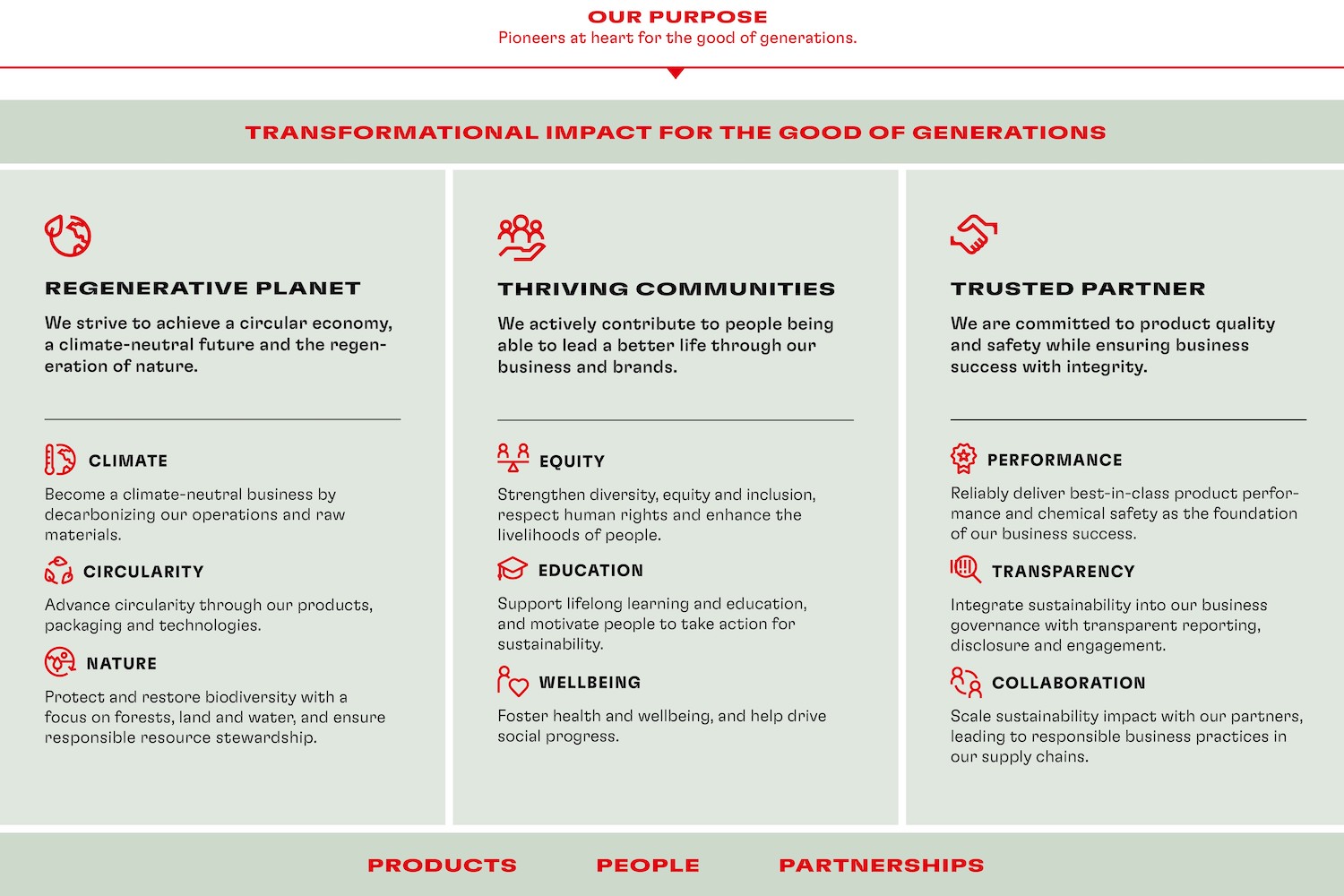
Below are a just few highlights from our 2022 Sustainability Report — stepping stones in our ongoing journey of sustainability, and how we are implementing action here in North America.
Regenerative planet
At Henkel, we continuously strive to transform our processes, products and use of raw materials to provide relief for our planet. Using more renewable ingredients in our products and packaging and leveraging energy efficiency technology at our manufacturing sites are two effective strategies. For example:
- Here in North America, a five-year collaboration with Shell will replace up to 200,000 tonnes of fossil-based feedstocks used in the manufacture of laundry surfactants (an ingredient that helps lather and lift dirt) with feedstocks that are based on renewable raw materials. The renewable-based surfactants will be used in many varieties of Persil, Purex and All brands.
- Across our North American manufacturing sites, Henkel is committed to sustainability progress. For example, in 2022, our adhesive plant in Cannon Falls, Minnesota, installed a new, energy-efficient cooling system that will save an estimated 18,000 cubic meters of water every year. In addition, an overhaul to a more efficient thermal oxidizing process resulted in annual natural gas savings of approximately 1,100 megawatt-hours of energy and a significant positive climate impact due to lower emissions.
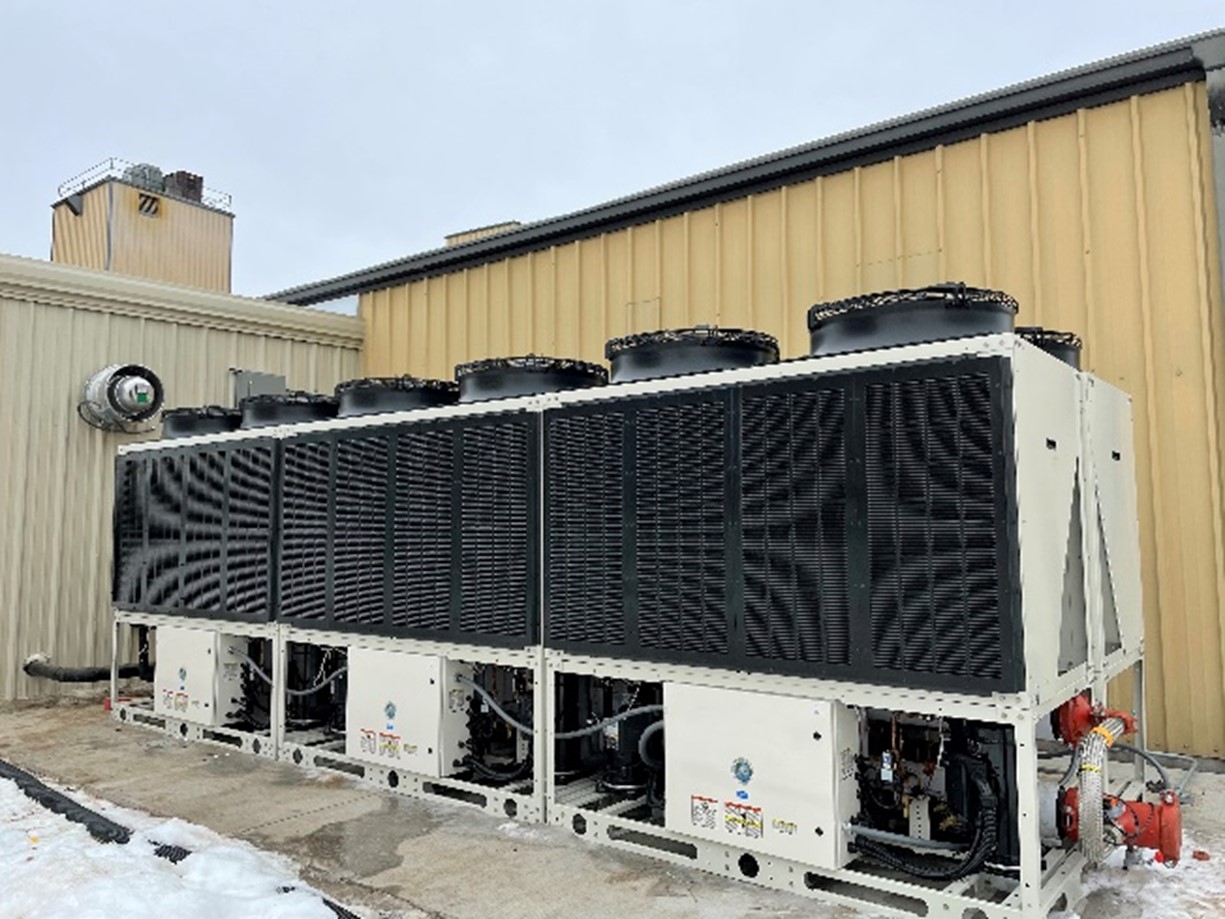
Thriving community
Through our business and brands, Henkel directly contributes to quality of life around the world. Beyond that, our desire to create sustainable change for customers and communities makes social engagement a driving force at Henkel. We support sustainable social projects around the world through volunteerism, social partnerships, emergency aid and brand engagement. Here are just a few examples:
- To cultivate curiosity and build science, technology, engineering and math (STEM) skills in young people, Henkel Researchers’ World (known as “Forscherwelt” in German) provides a research and development-based educational curriculum that has reached more than 81,000 children around the world since 2011.
- Here in North America, we launched the Henkel Researchers’ World program in Stamford, Connecticut, in 2021, in partnership with local nonprofit Mill River Park. The program has already reached more than 1,000 children. We look forward to expanding the program to reach more children, who may one day bring their STEM skills to the Henkel team.
- Another signature program, Make an Impact on Tomorrow (MIT), supports thriving communities through employee volunteerism. Celebrating its 25th year in 2023, the MIT program provides financial and other resources to support the causes closest to our employees’ hearts. Since the MIT initiative was launched in 1998, Henkel has provided $41 million to support over 17,000 charitable projects in more than 100 countries. In 2022, the work of Henkel volunteers in North America impacted the lives of more than 110,000 people.
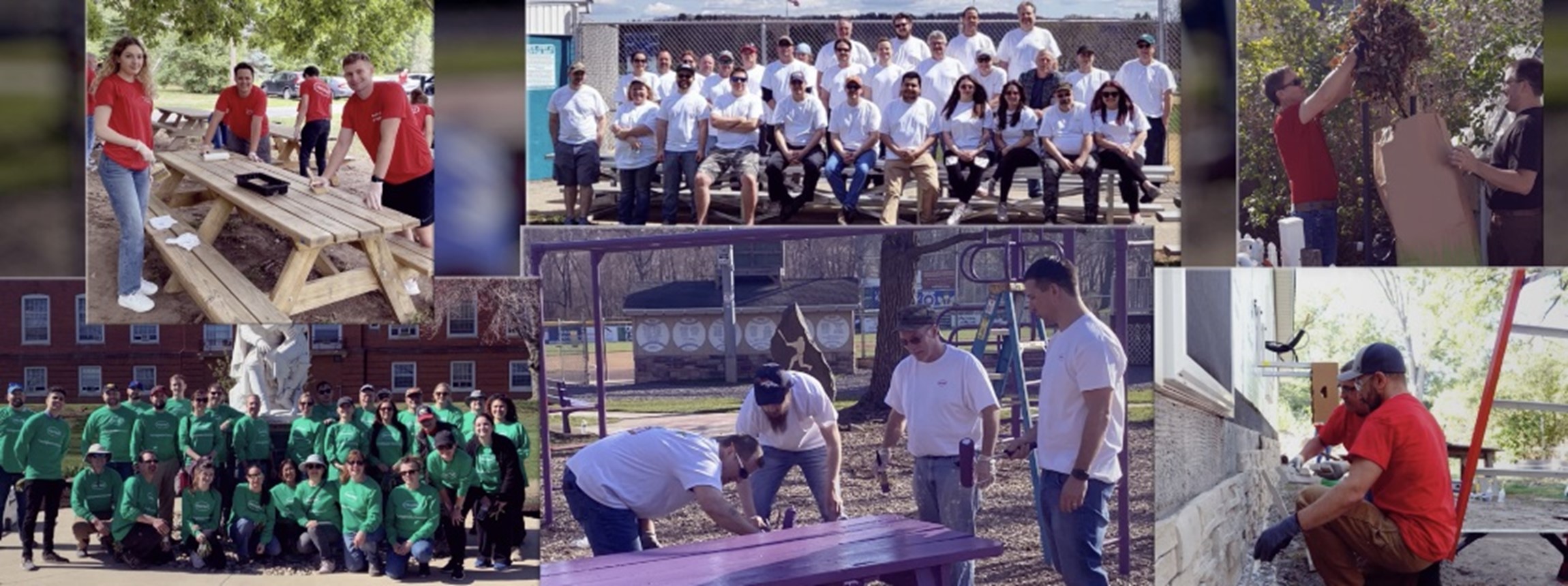
Trusted partner
Today, Henkel strives to view every aspect of our business through a sustainability lens. And we report on sustainability progress openly to further build trust with stakeholders who share our concern for the environment. Here are two ways we are partnering to better the planet:
- Through a long-term partnership with Novozymes, we have developed new variants that increase the concentration of key enzyme outputs in detergents and cleaning agents by up to 40 percent. This enables us to eliminate about 1,000 metric tons of carbon emissions per year.
- Celebrating 10 years of partnership, Henkel and Solidaridad recently announced a grant from personal care brand Dial to help create 35,000 acres of farmland for certified sustainable palm oil production in Colombia and provide 250 farmers with training and access to additional financial support.

These are just a few of the ways our sustainability strategy is creating measurable, meaningful change. For more information about our efforts, please check out our 2022 Sustainability Report, or the sustainability page on the Henkel North America website.
While we are proud of our successes at Henkel, we know that we need to stay full speed ahead when it comes to sustainability. Henkel continues to bring that same pioneering spirit to create a more sustainable world for future generations. There’s no area where innovation is more important.
This article is sponsored by Henkel North America.
Images courtesy of Henkel
Investment in People and Ideas is Key to Climate Change Adaptation for Tourism-Dependent Countries


The lush Blue Mountain range in eastern Jamaica.
Jamaica is calling for investment in human capital and ideas to build capacity for climate change adaptation.
Despite contributing the least to global emissions, tourism-dependent regions like the Caribbean are hugely vulnerable to the impacts of climate change and disasters like pandemics. They struggle with economic resilience and social stability from an inability to recover well, and recover quickly, Edmund Bartlett, Jamaica’s minister of tourism, said at the 2023 Global Inclusive Growth Summit last week co-hosted by the Mastercard Center for Inclusive Growth and The Aspen Institute.
The struggle to recover is made clear in the numbers. Tourism accounted for just over 29 percent of Jamaica’s economy in 2019, according to the World Travel and Tourism Council. That dropped to just over 18 percent in 2021 as the industry worked to bounce back from the pandemic. The number of tourism-related jobs also dropped from almost 30 percent of the country’s total jobs in 2019 to around 23 percent in 2021.
The minister called for investment in local youth, innovation, knowledge, and skills to enable small, developing and underdeveloped countries to become resilient.
“Ideas, ideas, ideas,” he said. “We need investment in ideas. That’s a power— to create innovation, to be creative and to add value. And I want to leave you with that because that’s what we need — to add value.”
This is not the first time the Ministry of Tourism has emphasized investment in the country’s youth. In 2018 it helped launch a $100 million program that gave high-school students the opportunity to earn an entry-level qualification in tourism. And in 2022 the Tourism Innovation Incubator started a search for innovative tourism solutions that will give 25 winners access to training, mentoring and the chance to pitch their ideas to investors.
Prioritizing local innovation is already paying off in another tourism-dependent country: Costa Rica. Its success comes from an emphasis on ecotourism — travel directed toward supporting environmental conservation and the well-being of locals.
The tourism industry makes up 6 percent of the country’s economy and accounts for almost 10 percent of total jobs, according to the World Travel and Tourism Council. Both are down from 11 percent in 2019.
The emphasis on ecotourism balances the industry’s economic importance with climate change mitigation. Costa Rica alone makes up about 5 percent of the world’s biodiversity, and 25 percent of the country’s land is protected — including 29 national parks, 19 wildlife refuges and eight biological reserves, according to its Tourism Board.
The country contributes only 0.02 percent of global greenhouse gas emissions, yet it is on track to meet the emission reduction targets set in the Paris Agreement to limit global warming to 1.5 degrees Celsius, according to the United Nations Development Program.
One growing ecotourism project is El Camino de Costa Rica, a hiking trail that crosses the country from the Atlantic Ocean to the Pacific Ocean, passing through rural villages along the way. It harnesses the power of the tourism industry to support the sustainable economic development of inland communities and small businesses instead of only towns on the coasts.
The trail is also an opportunity to promote environmental education and biodiversity protection. Mar a Mar, the nonprofit in charge of El Camino, built a center for communities to connect near Barbilla National Park and a hiker’s camp owned and operated by a local community. It plans to build another center to host biodiversity and environmental education, training and research.
Local innovation can lead to economic growth that supports climate change mitigation and adaptation. When loss and damage funding is discussed again at the COP28 climate talks in December, it is crucial to heed the calls of those who are experiencing the worst effects of the climate crisis. They are already developing their own solutions. They know best what they need. And they, like Bartlett, know how best we can support them: “Invest in ideas, that’s the future of the world.”
Image credit: Yves Alarie/Unsplash
Engaging with SMEs Can Unlock Critical Scope 3 Emissions Data
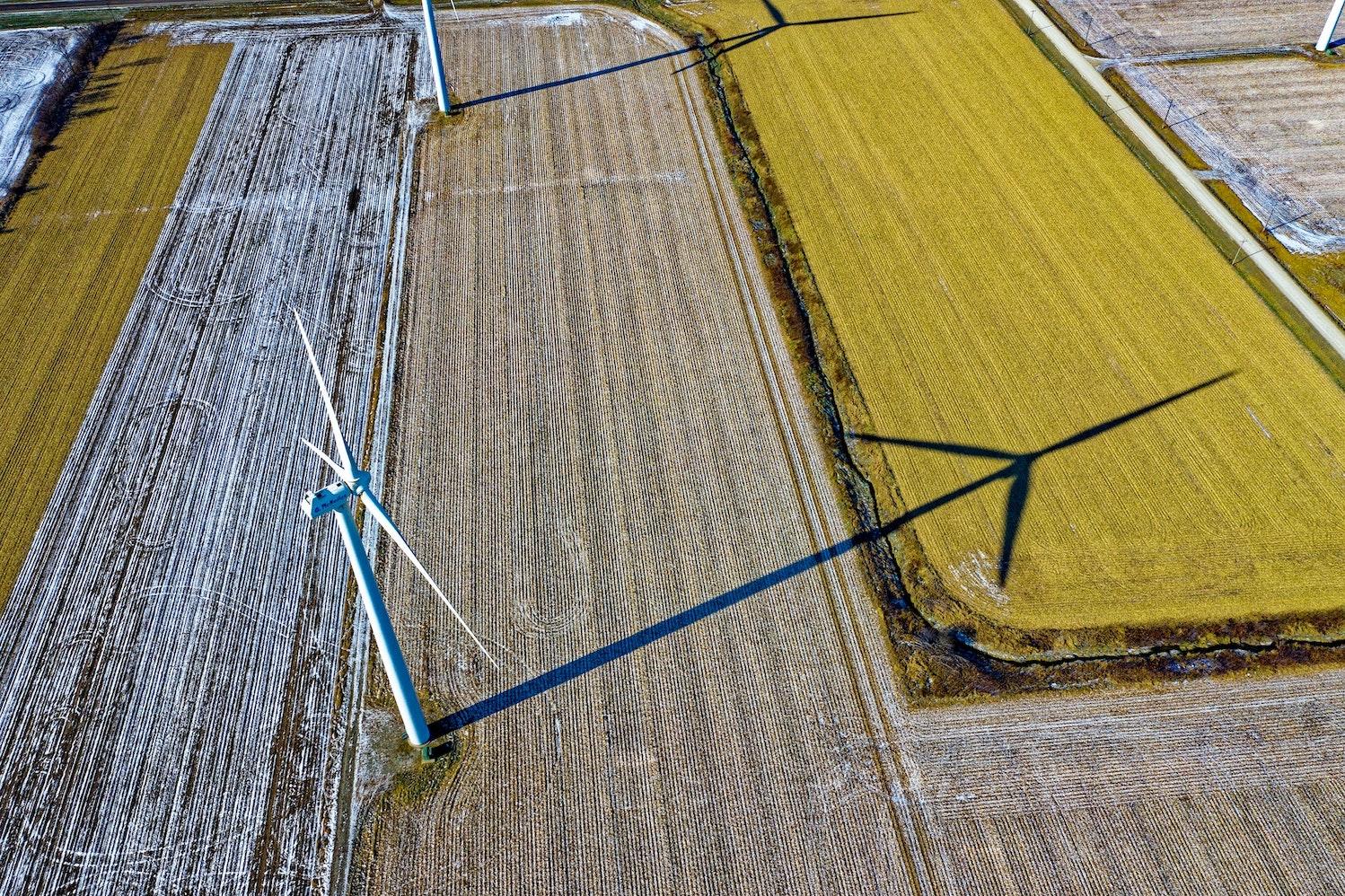
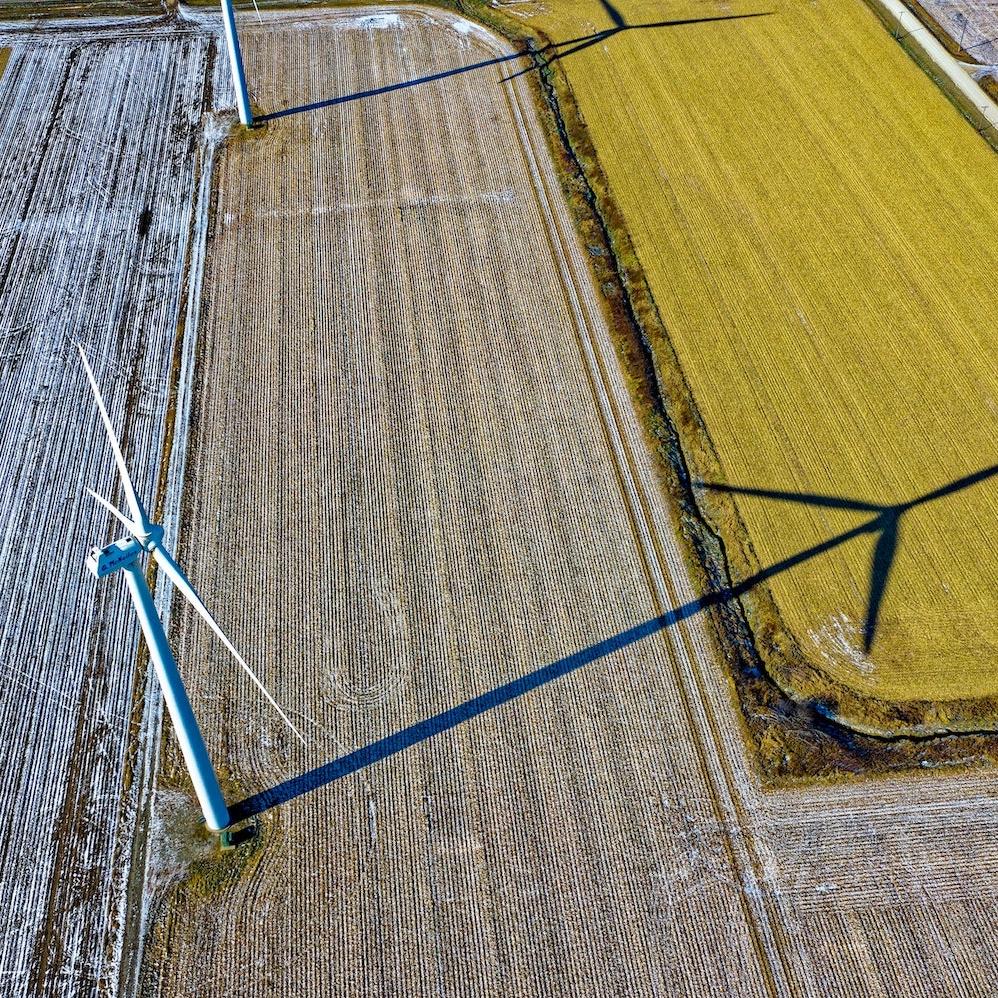
For large companies intent on gathering the full scope of greenhouse gas emissions data to meet their climate goals, working together with suppliers is the only way to assess the crucial Scope 3 emissions. These are the indirect emissions produced both upstream and downstream across the value chain that account for 75 percent of companies’ GHG emissions on average.
While Scope 3 is hugely important for corporate climate risk disclosure, companies have the least control over these emissions compared to Scope 1, direct emissions from owned or controlled sources, and Scope 2, indirect emissions from the generation of purchased electricity.
That’s where collaboration comes into play — recognizing that every supplier, no matter the size, is part of the bigger picture. Small- to- medium-sized enterprises may seem less consequential than the large companies they supply, but collectively, they have a huge impact: SMEs make up 90 percent of businesses worldwide and affect the livelihoods of over 2 billion people. Together, they rack up emissions (63 percent of business emissions in Europe, for example), and the way they choose to conduct business impacts ecosystems and people’s quality of life in all corners of the world.
As larger businesses make commitments to track, disclose and reduce their environmental impacts — particularly their Scope 3 greenhouse gas emissions — they also have a responsibility to source from more sustainable suppliers and to work with their suppliers to change their practices if needed.
An approach that emphasizes collaboration and partnership — rather than top-down edicts and demands for data without context or time to prepare — will be far more successful in winning over most suppliers, says Andy Bastien, senior product manager for water and supplier transparency at the ESG and sustainability software company FigBytes.
“If you are asking someone for this information — for data on emissions you don’t control — you should make sure they understand that ask,” Bastien explains. “Your suppliers might be large organizations or small mom-and-pop shops. And if you want them to provide specific Scope 3 data, that will require a level of engagement and transparency for both company and supplier to work together to become better stewards of the climate together.”
Growing pressure for Scope 3 data
The demand for Scope 3 emissions data will not lessen any time soon. In fact, it is likely to increase, given changing regulatory requirements on how companies disclose their climate risks and a trend of standardized climate and environmental reporting.
That includes a forthcoming climate risk disclosure rule from the U.S. Securities and Exchange Commission (SEC) that, as TriplePundit has reported, few companies are prepared to meet. Regulatory scrutiny on company climate performance is part of a global trend: In the European Union, the EU Corporate Sustainability Reporting Directive entered into force this year, broadening the entities that need to report to some 50,000 companies, including SMEs.
On the standardization side, the International Sustainability Standards Board (ISSB) will soon require the companies using its reporting framework to disclose a range of information to assess climate risks and climate resilience. Its first two IFRS Sustainability Disclosure Standards are set to be released in June 2023 and become effective as of Jan. 1, 2024.
Not least, investors want to see Scope 3 emissions data as they try to understand the climate-related risks of their investments — and many have supported the push for the SEC disclosure rules.
Even if Scope 3 emissions are not included in the final SEC climate disclosure rule for large companies, other regulations — such as the proposed disclosure rule for U.S. federal contractors — underscore why companies need to raise their game on supplier relationships.
Best practices for engaging suppliers
With fewer resources at their disposal, many SMEs are wondering how they can meet their customers’ demands for Scope 3 emissions data. While half of SMEs surveyed by the U.N.-backed SME Climate Hub calculate emissions and 60 percent have plans to reduce carbon impact, two-thirds are worried they don’t have the right skills and knowledge to tackle climate change.
Clearly, collaboration and partnership to overcome those types of barriers would be welcome. Bastien has found the most success with companies that understand their own house and what they are trying to achieve.
The companies that are successful at supplier data-gathering “look at it as an engagement policy, not an enforcement policy,” Bastien says. “Some large organizations may be able to command some leverage with their suppliers due to size alone, but most organizations don’t have that kind of leverage. The best approach is when companies look to adopt the role of an educator or enabler of their suppliers, rather than being prescriptive with top-down demands.”
Collaborative approaches that companies may want to consider include putting together a supplier code of conduct, if they don’t already have one, so suppliers have a clear understanding of expectations. Some organizations might use a survey to gauge the level of knowledge among their suppliers on Scope 3 and other climate risk information, or hold webinars or information sessions to raise awareness. Technology of course, serves a critical role too. Climate management software solutions help ease the burden of Scope 3 emissions data gathering for both companies and their suppliers.
Industry sectors can also look to join forces to support one another on meeting the increased demand for climate data. “There is power in numbers,” Bastien says.
Yet despite well-intentioned efforts, some suppliers may be reluctant to share their data, he acknowledges. Some organizations may see revealing their climate-related data as a negative rather than a positive, posing a risk that they might lose a contract if their performance is seen as lacking.
“That’s where engagement has to go hand-in-hand with transparency, so that suppliers can see this collaboration on improving climate and ESG performance as an asset rather than a liability,” Bastien explains.
No avoiding the downward pressure
For SMEs that may be hesitant to open up about their emissions to their customers, regulatory scrutiny on climate risk disclosure will soon make this everyone’s business.
“SMEs should understand that when these bigger players are mandated and regulated to report, it will put downward pressure on everyone to have their house in order,” Bastien says. “Whether you are a small supplier and don’t think you are affected by these regulations, if you are working for a bigger supplier, it is trickling down to you at the end of the day, and your own suppliers as well.”
Seeing the opportunity rather than the risk
Knowledge is power, and SMEs that fully understand their emissions performance can not only keep a positive relationship with their customers, but also pass that knowledge down to their own suppliers. In this way, Scope 3 emissions data becomes just another line in the accounting ledger, all along the value chain.
“Scope 3 GHG emissions are becoming part of the new reality, of every company’s bottom line, so putting yourself ahead of that risk and helping your suppliers reduce their risk is just a smart way to run your business,” Bastien says.
“The more we can ensure everyone takes the importance of doing their part to heart, the more we can get better data and have everyone across the value chain improve in terms of bringing down emissions,” he adds. “The entire chain gets a better lift when everyone does their part.”
And again, given the changing regulatory and reporting landscapes, there is no way around it. As Bastien puts it: “Achieving the desired outcome around Scope 3 is a matter of everyone raising their games together, because that is how we ultimately will be successful on this path to decarbonization.”
This article series is sponsored by FigBytes and produced by the TriplePundit editorial team.
Image credit: Tom Fisk/Pexels